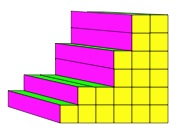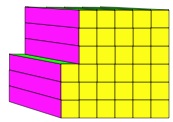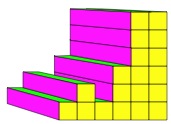Stairs
Let's suppose that you are working in the school hall to help with setting up the stage for a play or an assembly. Perhaps you've got a stage that is raised up and there are some steps that lead up to the stage. From the side the steps might look a bit like this:-

These steps have been made up using blocks so that you go up a total of 6 and along a total of 6. The steps could have been made up another way:-

In this case the steps are not equal and some of them need you to make a big step up. Well, that does not matter.
Have a go at drawing some other steps that would take you up 6 and along 6.
My challenge to you today is to design different step arrangements, with the following rules:-
You need to go along a distance of 6 on the steps, so this one breaks the rule:-

You need to end up at 6 high. So this next one breaks the rule and is not allowed:-
You cannot go DOWN once you have gone up. So this next one is not allowed either:-
But, you can go along more than one block without going UP like this one:-

As a little extra, you may have noticed that you can count how many square blocks have been used for each design.
The very first example above used 21 and the last one used 33 square blocks.
Here are some questions you might like to think about to do with the number of square blocks used:-
- What is the largest number of square blocks that can be used?
- What is the smallest number of square blocks that can be used?
- Can you get to use all the numbers that go between your answer to a. and your answer to b. ?
Then :-
I wonder what would happen if it were 4 along and 4 up?
I wonder what would happen if it were 5 along and 5 up?
I wonder what would happen if it were 5 along and 6 up?
I wonder what would happen if it were 6 along and 5 up?
I wonder what would happen if ...?
Please send in your solutions and comments.
Try some practical approches with blocks and get a discussion going to reinforce what is and what is not allowed.
Can you find a way of doing this so that if you had the time you'd know you had found all the ways?
Explore variations like 3 across, 4 up etc.
Using 3D blocks all through the the work will help all children access this challenge.





